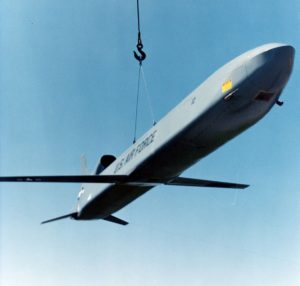I have an op-ed in Defense News that explains how deploying the planned new nuclear-armed cruise missile will actually make the United States less secure. Known as the Long-Range Standoff Weapon, or LRSO, it will be significantly more capable than the existing nuclear-armed air-launched cruise missile (ALCM). And for just that reason, by demonstrating that the United States sees this weapon as a valuable military tool, it will undermine higher priority U.S. security goals.

The Air-Launched Cruise Missile, or AGM-86B, on display at the National Museum of the United States Air Force. Photo: U.S. Air Force
Specifically, pursuing the LRSO ignores the reality that nuclear weapons are no longer a security asset for the United States, but a liability that should be constrained. The LRSO, by being more capable and more “usable,” will undermine the sensible commitment that President Obama made to reduce the role of nuclear weapons in U.S. security policy. Doing so is essential if the U.S. is to reduce the risk of nuclear use. Moreover, it is only by reducing the role of nuclear weapons that the United States can lead the world to a place where the nuclear threat is significantly limited.
What are the new or improved capabilities that the LRSO will have in comparison to the existing ALCM? Start with the handy table I put together for the Defense News piece:
Capability |
Existing ALCM |
Proposed LRSO |
| Stealthy | No | Yes |
| Supersonic | No | Potentially |
| Extended Range | No | Yes |
| Re-targetable | No | Potentially |
| Improved Variable Yield | No | Yes |
| Multiple Delivery Platforms | No | Yes |
| Increased Accuracy | No | Yes |
That is a long list of capabilities, one that deserves some explanation. Of course, specific information about the LRSO is classified, but presumably the system will be more advanced than the nuclear-armed Advanced Cruise Missile (ACM), which was first deployed in 1990 and retired in 2007. The LRSO may also incorporate technologies from more recent conventionally-armed cruise missiles. Those systems are used here as a benchmark for the LRSO, and Congressional staff indicate the assessments below are largely correct.
Stealthy: The Advanced Cruise Missile was stealthy and harder to detect than the ALCM. DOD officials continually emphasize that the LRSO is needed to penetrate advanced air defenses, a capability that would be greatly enhanced by stealth.
Supersonic: The official “Request for Information” for the LRSO issued by the Air Force lists “engine options” that include supersonic capability. However, cruise missiles travelling faster than the speed of sound (supersonic) have less range and such high speed detracts from stealth, so this may not be a final requirement.
Extended Range: The official range for the ALCM (designated AGM-86B by the Air Force) is 1,500-plus miles. The range for the ACM (designated AGM-129A by the Air Force) was “more than 2,000 miles.”
Re-targetable: Once an ALCM is released from the B-52 bomber that carries it, it operates autonomously, relying on internal inertial navigation with terrain contour-matching updates to provide guidance. However, original plans for the Air Force’s most advanced long-range conventional cruise missile, the JASSM-ER, included a data link that would allow in-flight communication, meaning it could be re-targeted while in flying on its own. In the end it was not included because of budget cuts, but such a data link could be included in the LRSO.
Improved Variable Yield: The ALCM is believed to have a selectable yield of 5 KTs or 150 KTs. The lower yield is presumably for the boosted primary alone, and the larger yield for the two-stage weapon. The life-extension program for the W80 warhead, which will be carried by the LRSO missile, is expected to provide closer to a “dial-a-yield” option that would allow a number of yield options.
Multiple Delivery Platforms: The ALCM can only be carried by the B-52. The LRSO will be carried by the B-2, the B-52, and the new strategic bomber in development, the Long-Range Strike Bomber, or LRS-B.
Increased Accuracy: The ALCM is reported to have an accuracy of 30+ meters. Modern conventional cruise missiles, which include GPS systems on board, are far more accurate. Although it is not clear if the LRSO will use GPS, a data link could also potentially help with guidance.
As I note in the Defense News piece, given that long list of enhanced capabilities, it not clear that the LRSO complies with the Obama administration’s policy that it will not develop new nuclear weapons and that warhead life extension programs like the one that is part of the LRSO program “will not support new military missions or provide for new military capabilities,” as declared in the 2010 Nuclear Posture Review.
In sum, based on these capabilities, the LRSO will clearly be a significantly more capable system than the existing ALCM. Indeed, one former Hill staffer briefed on the program stated that the LRSO will be “a hundred times” more capable than the ALCM.
And that is exactly why the United States would be better off if the Obama administration cancelled the program.
Featured photo: The Advanced Cruise Missile, retired in 2007, was stealthy and had a longer range than the currently deployed Air-Launched Cruise Missile. (U.S. Air Force Photo)

